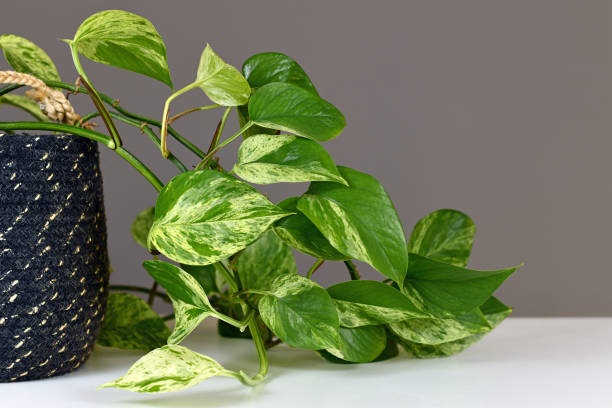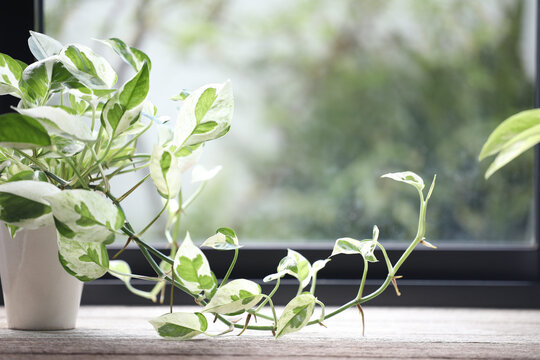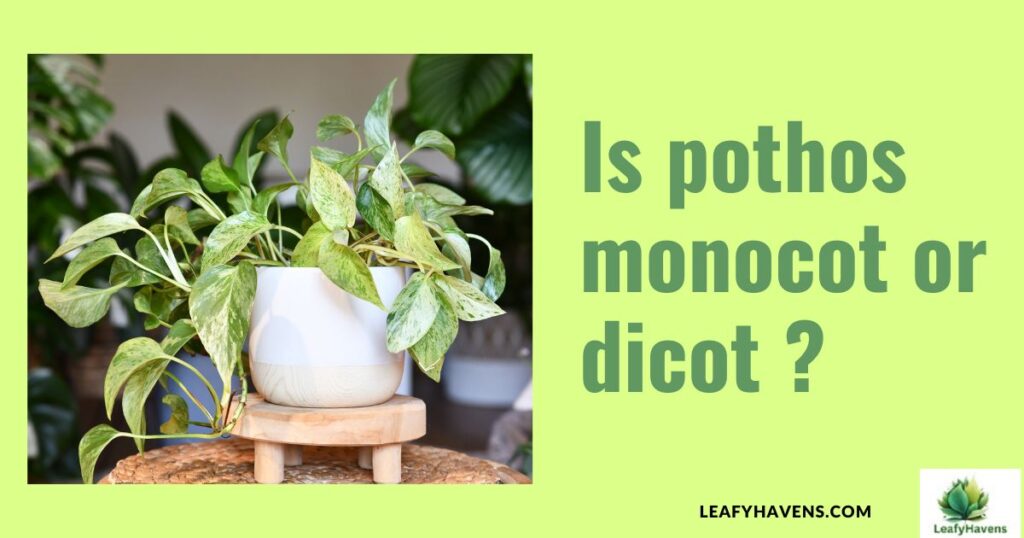One of the most common houseplants is the pothos, which is adored for its rich green foliage and low maintenance requirements. But many people are confused about its botanical classification: Is pothos monocot or dicot? The answer is : pothos plant (Epipremnum aureum) is classified as a monocot. The answer to this question will help you comprehend the plant’s growth patterns, leaf structures, and other features. Let’s examine this subject in more detail.
- Understanding the Basics: What Are Monocots and Dicots?
- Is Pothos Monocot or Dicot?
- Key Characteristics of the Pothos Plant
- Why Understanding This Matters for Plant Care
- Step-by-Step Guide to Growing and Propagating Pothos
- Why You Should Buy a Pothos Plant
- Final Thoughts
- FAQs About Is Pothos Monocot or Dicot?
You may want to read: How Big Do Money Plants Grow?
Understanding the Basics: What Are Monocots and Dicots?
Before we can determine if the pothos plant is a monocot or dicot, it’s important to understand these two categories:
- Monocots: Plants that have a single seed leaf (cotyledon). They usually display parallel leaf venation and flower parts in multiples of three.
- Dicots: Plants with two seed leaves (cotyledons). They generally have reticulate (net-like) leaf venation and flower parts in multiples of four or five.
These distinctions not only affect how plants grow but also influence their care and propagation.
Is Pothos Monocot or Dicot?

The pothos plant (Epipremnum aureum) is classified as a monocot. Let’s explore why:
1. Leaf Venation
Monocots are characterized by parallel veins, and the pothos plant exhibits this feature. Its leaves have a structure where veins run in a somewhat parallel fashion, even though they might appear slightly reticulated at first glance.
2. Seed Structure
Although propagation of pothos is often done through cuttings, in its natural habitat, the seeds of the plant develop with a single cotyledon, confirming its classification as a monocot.
3. Flower Arrangement
In flowering monocots, floral parts are arranged in multiples of three. While the pothos plant rarely flowers indoors, its flowers in the wild align with the characteristics of monocots.
Key Characteristics of the Pothos Plant
To fully appreciate the plant’s nature, here are some vital characteristics that make the pothos plant unique:
- Growth Habit: A trailing or climbing vine that thrives in low light.
- Leaf Shape: Heart-shaped leaves with vibrant green or variegated patterns.
- Root System: Fibrous roots, typical of monocots, allowing for efficient absorption of water and nutrients.
Why Understanding This Matters for Plant Care

Knowing whether the pothos plant is monocot or dicot can help you better care for it. Here are a few tips tailored to the plant’s monocot nature:
1. Soil Requirements
Monocots like pothos prefer well-draining soil. A mix of potting soil with perlite or sand can mimic the plant’s natural environment and promote healthy root development.
2. Watering Needs
Since pothos has a fibrous root system typical of monocots, it absorbs water quickly. Water the plant only when the topsoil feels dry to avoid overwatering.
3. Light Preferences
Pothos thrives in indirect light, making it an excellent indoor plant. However, its classification as a monocot means it can adapt to varying light conditions, including low light.
Step-by-Step Guide to Growing and Propagating Pothos
1. Choosing the Right Spot
Select a location with bright, indirect light. Ensure the area is warm, as pothos prefers tropical conditions.
2. Preparing the Soil
Use a well-draining potting mix designed for monocots. Add organic matter to boost nutrient content.
3. Watering Correctly
Check the soil’s moisture level before watering. Too much water can lead to root rot.
4. Fertilizing for Growth
Feed your pothos with a balanced, water-soluble fertilizer every 4–6 weeks to encourage healthy leaves and vines.
5. Propagating with Confidence
Cut a healthy stem just below a node, ensuring it has at least two leaves. Place the cutting in water or soil, and watch roots develop within weeks.
Why You Should Buy a Pothos Plant

The pothos plant is a perfect addition to any home. Its monocot nature ensures rapid growth, resilience, and adaptability. Whether you’re a seasoned gardener or a beginner, this plant’s ability to thrive in various conditions makes it a must-have. Plus, its air-purifying properties add an extra layer of value.
Final Thoughts
Knowing the answer to the question, ” is pothos monocot or dicot ?” can help you appreciate this amazing plant more, regardless of whether you’re a plant enthusiast or a curious novice. You will be more prepared to effectively care for and propagate it if you are aware that it is classified as a monocot. Enjoy the beauty and advantages of bringing a pothos plant home with you now!
FAQs About Is Pothos Monocot or Dicot?
1. What is the scientific classification of pothos?
The pothos plant, scientifically known as Epipremnum aureum, is classified as a monocot in the Araceae family.
2. Does the monocot classification affect pothos care?
Yes, as a monocot, pothos benefits from well-draining soil, moderate watering, and indirect sunlight.
3. Can pothos grow in low light conditions?
Absolutely! The pothos plant is highly adaptable and can thrive in low light, making it ideal for indoor spaces.
4. How do I propagate a pothos plant?
Propagation is simple. Take a cutting with at least one node and place it in water or soil until roots form.
5. Why is pothos considered a beginner-friendly plant?
Its hardy nature, rapid growth, and low maintenance make the pothos plant a perfect choice for beginners.





